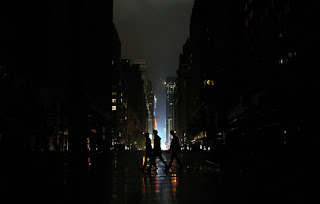Hurricane Sandy recently plunged New York, one of the
biggest cities in the world, into total darkness as power outings hit the Big
Apple in one of the biggest storms to hit the east coast in years.
 |
| New York residents make their way through the blackout |
In the UK meanwhile, safe from the effects of such tropical
weather patterns, local authorities up and down the country are facing a
nightmare of a very different nature – the choice between making vital
cost-cutting measures and ensuring the safety of local residents.
That’s how many see the decision to switch off thousands of
street lights in order to save money on energy bills.
Many local residents have experienced a blackout usually in
the early hours of the morning, as the cost of keeping the street lighting
network running all night is proving too much for local councils already under
pressure to trim costs due to diminished government funding.
A Daily Telegraph investigation that took place on the day the clocks went back an hour found more than 3,000 miles of motorways and trunk roads were completely unlit, and a further 47 miles of motorway have their lights switched off between midnight and 5am.
A Daily Telegraph investigation that took place on the day the clocks went back an hour found more than 3,000 miles of motorways and trunk roads were completely unlit, and a further 47 miles of motorway have their lights switched off between midnight and 5am.
Earlier this year Nottinghamshire County Council announced
it would turn off 90,000 street lights in order to save an estimated £1.25m,
following Derbyshire County Council’s similar decision to save more than
£400,000 a year by switching off street lights in rural areas between midnight
and 5.30am. An investigation by the Daily Mail in fact found out that 21
out of 27 county councils in England were turning street lights off at certain
times, or in some cases entirely, back in February.
.jpg) | |
|
Pedestrians are at particular risk - according to
governmental crime statistics the number of personal robberies occurring in
England and Wales has fallen progressively in the last four years but in
2009/10, the most recent year available, there were still nearly 80,000 cases
recorded by the Police. The same can be said of sexual offences, with over 50,000
incidents reported to Police between July 2011 and June 2012. With pedestrians
highly likely to be targets for both these crimes, effective and reliant street
lighting is clearly vital to ensure their safety.
But how can councils balance the need for this safety with
their tighter budgetary requirements and rising energy prices? By
changing the type of lighting these authorities use, their street lighting
could in fact remain on throughout the night whilst seeing their energy bills
reduced thanks to more efficient LED street lighting.
LEDs convert more power to light, as opposed to traditional
lighting sources that lose power through excess heat, and with no filament to
burn out they are more reliable and can save users money on maintenance bills.
With a life span of up to 100,000 hours LED street lights
offer long-term solutions for financially conscious councils. Schemes, such as the Green Lease for LED lighting, are
even available whereby purchasers can offset the capital expenditure of LED
replacement lights by making repayments through the savings they make in energy
costs.
As part of the Telegraph investigation the Royal Society for the Prevention of Accidents said: "The presence of lighting not only reduces the risk of
traffic accidents but also their severity. Surveys have shown that the public
are in favour of street lighting as a way of improving road safety and that, if
anything, it needs to be improved in some areas. There are economic and environmental reasons why some
organisations may wish to reduce the amount of lighting. However there are
safety reasons why lighting needs to be available."
With new LED technology, road safety and cost-efficiency need no longer be separate considerations for hundreds of authorities up and down the country, and the blackouts that are concerning so many, can be a thing of the past.
Have the street lights in your area been switched off? Give us your thoughts in the comments box below.
With new LED technology, road safety and cost-efficiency need no longer be separate considerations for hundreds of authorities up and down the country, and the blackouts that are concerning so many, can be a thing of the past.
Have the street lights in your area been switched off? Give us your thoughts in the comments box below.
No comments:
Post a Comment